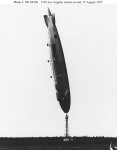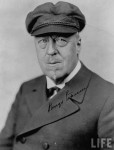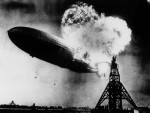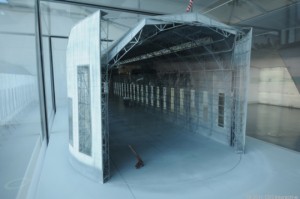 On July 2, 1900, the first rigid airship designed by Count Ferdinand Adolf Heinrich August Graf von Zeppelin took to the air from a floating hangar on Lake Constance near the factory where it was built in Friedrichshafen, southern Germany. The LZ1 (LZ stood for Luftschiff Zeppelin or Airship Zeppelin) carried five people and flew for 20 minutes until the wind forced it to land in the water, damaging the craft. Count Zeppelin just kept on working on new LZ models until by 1909, Zeppelins were used both in German military and civilian aviation.
On July 2, 1900, the first rigid airship designed by Count Ferdinand Adolf Heinrich August Graf von Zeppelin took to the air from a floating hangar on Lake Constance near the factory where it was built in Friedrichshafen, southern Germany. The LZ1 (LZ stood for Luftschiff Zeppelin or Airship Zeppelin) carried five people and flew for 20 minutes until the wind forced it to land in the water, damaging the craft. Count Zeppelin just kept on working on new LZ models until by 1909, Zeppelins were used both in German military and civilian aviation.
 Zeppelin died in 1917, before the end of World War I and the Treaty of Versailles which dismantled the Zeppelin program. His successor at the metaphoric helm of the Zeppelin company and later at the literal helm of the record-breaking Graf Zeppelin, the most successful rigid airship of all time, was Dr. Hugo Eckener. He cleverly overcame the Versailles prohibition by building the LZ-126 and offering it to the U.S. Navy as part of Germany’s war reparations. It was commissioned the USS Los Angeles in 1924. Its lifting hydrogen gas replaced with blissfully inert helium, the Los Angeles would go on to become the longest serving airship in the Navy.
Zeppelin died in 1917, before the end of World War I and the Treaty of Versailles which dismantled the Zeppelin program. His successor at the metaphoric helm of the Zeppelin company and later at the literal helm of the record-breaking Graf Zeppelin, the most successful rigid airship of all time, was Dr. Hugo Eckener. He cleverly overcame the Versailles prohibition by building the LZ-126 and offering it to the U.S. Navy as part of Germany’s war reparations. It was commissioned the USS Los Angeles in 1924. Its lifting hydrogen gas replaced with blissfully inert helium, the Los Angeles would go on to become the longest serving airship in the Navy.
 It was tough, too, unlike its famous sibling the Hindenburg. Many of the naval airships ended in flaming disaster, but the Los Angeles was decommissioned and dismantled in 1939 after a decade-long tour of duty. It even survived a scary encounter with the elements at the Lakehurst, New Jersey airfield that saw the Hindenburg‘s destruction. On August 25, 1927, a strong wind lifted the tail of the Los Angeles into a current of cold air that lifted the tail even higher. It reached an angle of 85 degrees before going back down, and despite having been basically vertical it was hardly damaged at all. The next day it went happily back to work.
It was tough, too, unlike its famous sibling the Hindenburg. Many of the naval airships ended in flaming disaster, but the Los Angeles was decommissioned and dismantled in 1939 after a decade-long tour of duty. It even survived a scary encounter with the elements at the Lakehurst, New Jersey airfield that saw the Hindenburg‘s destruction. On August 25, 1927, a strong wind lifted the tail of the Los Angeles into a current of cold air that lifted the tail even higher. It reached an angle of 85 degrees before going back down, and despite having been basically vertical it was hardly damaged at all. The next day it went happily back to work.
 Eckener followed up his successful revival of the Zeppelin airship program by going on a lecture tour to raise money for his next dirigible. The Weimar government was broke as a joke, so Eckener appealed directly to the German people. It worked, and in 1928 the Graf Zeppelin, piloted by Eckener himself, made the first intercontinental passenger airship flight from Friedrichshafen to Lakehurst.
Eckener followed up his successful revival of the Zeppelin airship program by going on a lecture tour to raise money for his next dirigible. The Weimar government was broke as a joke, so Eckener appealed directly to the German people. It worked, and in 1928 the Graf Zeppelin, piloted by Eckener himself, made the first intercontinental passenger airship flight from Friedrichshafen to Lakehurst.
The Graf Zeppelin became a symbol of German engineering, and Eckener was wildly popular as its courageous and skilled pilot and CEO. In 1932 he planned to run for President of Germany against Hitler, but decided not to when President Paul von Hindenburg declared himself a candidate for re-election. The Nazis hated Eckener and the feeling was profoundly mutual. It was only an intervention from Hindenburg himself that kept Eckener from getting thrown in jail.
 The Nazis got to him in another way: by nationalizing the Zeppelin company, dumping Eckener and many of his safety protocols, then enlisting the airships as propaganda tools for the regime. Before the Nazi takeover, the company had a perfect safety record under Hugo Eckener’s management. There were zero serious injuries sustained by Zeppelin passengers over more than 1 million air miles traveled. It was the nationalized, propagandized, slapdash Nazi operation that brought about the fiery end of the Zeppelin era on May 6th, 1937, when the Hindenburg burst into flames at the Lakehurst Naval Station. The explosion killed 35 of the 97 people on board and one person on the ground.
The Nazis got to him in another way: by nationalizing the Zeppelin company, dumping Eckener and many of his safety protocols, then enlisting the airships as propaganda tools for the regime. Before the Nazi takeover, the company had a perfect safety record under Hugo Eckener’s management. There were zero serious injuries sustained by Zeppelin passengers over more than 1 million air miles traveled. It was the nationalized, propagandized, slapdash Nazi operation that brought about the fiery end of the Zeppelin era on May 6th, 1937, when the Hindenburg burst into flames at the Lakehurst Naval Station. The explosion killed 35 of the 97 people on board and one person on the ground.
 That disaster has become cultural vernacular now, thanks to WLS radio reporter Herbert Morrison’s famously emotional “Oh the humanity!” commentary on the explosion. Had the Nazis had their way, we wouldn’t have ever heard it. It wasn’t broadcast live. Morrison and his sound engineer Charley Nehlsen had recorded it on acetate discs. The SS on site knew of the recordings and followed Morrison and Nehlsen to seize them before the bad publicity got out. The radio men had to hide for several hours before making a break for it and bringing the precious records to Chicago where they aired the next day on WLS.
That disaster has become cultural vernacular now, thanks to WLS radio reporter Herbert Morrison’s famously emotional “Oh the humanity!” commentary on the explosion. Had the Nazis had their way, we wouldn’t have ever heard it. It wasn’t broadcast live. Morrison and his sound engineer Charley Nehlsen had recorded it on acetate discs. The SS on site knew of the recordings and followed Morrison and Nehlsen to seize them before the bad publicity got out. The radio men had to hide for several hours before making a break for it and bringing the precious records to Chicago where they aired the next day on WLS.
Today’s entry is brought to you by this outstanding CNET article on the Zeppelin Museum in Friedrichshafen. There’s a magnificent slide show of the Zeppelin displays at the museum which is full of information and really underscores the hugeness of these airships.
Here, for instance, on the left is the original construction ladder used to build the Hindenburg. On the right is a scale model of the Hindenburg‘s hangar. That little toy on the bottom left is the construction ladder.


Check the rest of the article and pictures out because they are awesome. I’ll leave you with Morrison’s broadcast attached to some beautiful footage of the Hindenburg flying over New York City and the tragic footage taken at Lakehurst on the day of the disaster.